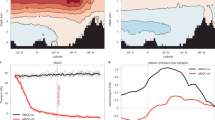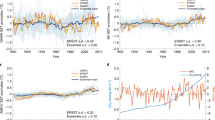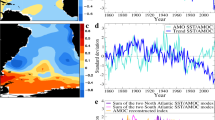Abstract
The Atlantic Meridional Overturning Circulation (AMOC) is an active component of the Earth’s climate system1 and its response to global warming is of critical importance to society. Climate models have shown an AMOC slowdown under anthropogenic warming since the industrial revolution2,3,4, but this slowdown has been difficult to detect in the short observational record5,6,7,8,9,10 because of substantial interdecadal climate variability. This has led to the indirect detection of the slowdown from longer-term fingerprints11,12,13,14 such as the subpolar North Atlantic ‘warming hole’11. However, these fingerprints, which exhibit some uncertainties15, are all local indicators of AMOC slowdown around the subpolar North Atlantic. Here we show observational and modelling evidence of a remote indicator of AMOC slowdown outside the North Atlantic. Under global warming, the weakening AMOC reduces the salinity divergence and then leads to a ‘salinity pile-up’ remotely in the South Atlantic. This evidence is consistent with the AMOC slowdown under anthropogenic warming and, furthermore, suggests that this weakening has likely occurred all the way into the South Atlantic.
This is a preview of subscription content, access via your institution
Access options
Access Nature and 54 other Nature Portfolio journals
Get Nature+, our best-value online-access subscription
$29.99 / 30 days
cancel any time
Subscribe to this journal
Receive 12 print issues and online access
$209.00 per year
only $17.42 per issue
Buy this article
- Purchase on Springer Link
- Instant access to full article PDF
Prices may be subject to local taxes which are calculated during checkout




Similar content being viewed by others
Data availability
All data used are publicly available online, as described in detail in the Dataset section of Methods. In addition, the POP2 data of the sensitivity experiments used in this study are available from the corresponding author upon request.
Code availability
POP2 is freely available as open-source code from http://www.cesm.ucar.edu/models/cesm1.1.
Change history
16 March 2022
In the version of this article initially published online, there was an error in ref. 11, which cited a corrigendum to Rahmstorf, S. et al. (2015), and not the original article. The references has been updated to the original article in the HTML and PDF versions of the article.
22 October 2020
A Correction to this paper has been published: https://doi.org/10.1038/s41558-020-00951-1
References
Buckley, M. W. & Marshall, J. Observations, inferences, and mechanisms of Atlantic Meridional Overturning Circulation variability: a review. Rev. Geophys. 54, 5–63 (2016).
Gregory, J. M. et al. A model intercomparison of changes in the Atlantic thermohaline circulation in response to increasing atmospheric CO2 concentration. Geophys. Res. Lett. 32, l12703 (2005).
IPCC Climate Change 2013: The Physical Science Basis (eds Stocker, T. F. et al.) (Cambridge Univ. Press, 2013).
Liu, W. et al. Overlooked possibility of a collapsed Atlantic Meridional Overturning Circulation in warming climate. Sci. Adv. 3, e1601666 (2017).
Bryden, H. L., Longworth, H. R. & Cunningham, S. A. Slowing of the Atlantic Meridional Overturning Circulation at 25° N. Nature 438, 655–657 (2005).
Robson, J., Hodson, D., Hawkins, E. & Sutton, R. Atlantic overturning in decline? Nat. Geosci. 7, 2–3 (2014).
Smeed, D. A. et al. Observed decline of the Atlantic Meridional Overturning Circulation 2004–2012. Ocean Sci. 10, 29–38 (2014).
Srokosz, M. A. & Bryden, H. L. Observing the Atlantic Meridional Overturning Circulation yields a decade of inevitable surprises. Science 348, 1255575 (2015).
Majumder, S., Schmid, C. & Halliwell, G. An observations and model based analysis of meridional transports in the South Atlantic. J. Geophys. Res. Oceans 121, 5622–5638 (2016).
Smeed, D. A. et al. The North Atlantic Ocean is in a state of reduced overturning. Geophys. Res. Lett. 45, 1527–1533 (2018).
Rahmstorf, S. et al. Exceptional twentieth-century slowdown in Atlantic Ocean overturning circulation. Nat. Clim. Change 5, 475–480 (2015).
Caesar, L. et al. Observed fingerprint of a weakening Atlantic Ocean overturning circulation. Nature 556, 191–196 (2018).
Thornalley et al. Anomalously weak Labrador Sea convection and Atlantic overturning circulation during the past 150 years. Nature 556, 227–230 (2018).
Thibodeau, B. et al. Last century warming over Canadian Atlantic shelves linked to weaker Atlantic Meridional Overturning Circulation. Geophys. Res. Lett. https://doi.org/10.1029/2018GL080083 (2018).
Moffa-Sanchez, P. et al. Variability in the northern North Atlantic and Arctic oceans across the last two millennia: a review. Paleoceanogr. Paleoclimatol. https://doi.org/10.1029/2018PA003508 (2019).
Chemke, R., Zanna, L. & Polvani, L. M. Identifying a human signal in the North Atlantic warming hole. Nat. Commun. 11, 1540 (2020).
Chen, X. & Tung, K. K. Global surface warming enhanced by weak Atlantic overturning circulation. Nature 559, 387–391 (2018).
Zhang, M., Wu, Z. & Qiao, F. Deep Atlantic Ocean warming facilitated by the deep western boundary current and equatorial Kelvin waves. J. Clim. 31, 8541–8555 (2018).
Johnson, H. & Marshall, D. A theory for the surface Atlantic response to thermohaline variability. J. Phys. Oceanogr. 32, 1121–1132 (2002).
Bingham, R. J., Hughes, C. W., Roussenov, V. & Williams, R. G. Meridional coherence of the North Atlantic Meridional Overturning Circulation. Geophys. Res. Lett. 34, 4–9 (2007).
Biastoch, A., Böning, C. W., Getzlaff, J., Molines, J. M. & Madec, G. Causes of interannual–decadal variability in the meridional overturning circulation of the midlatitude North Atlantic ocean. J. Clim. 21, 6599–6615 (2008).
Zhang, R. Coherent surface–subsurface fingerprint of the Atlantic Meridional Overturning Circulation. Geophys. Res. Lett. 35, L20705 (2008).
Lozier, M. S. Overturning in the North Atlantic. Annu. Rev. Mar. Sci. 4, 291–315 (2012).
Gu, S., Liu, Z. & Wu, L. Timescale dependence of the meridional coherence of Atlantic Meridional Overturning Circulation. J. Geophys. Res. Oceans https://doi.org/10.1029/2019JC015838 (2020).
Stocker, T. F. & Johnsen, S. J. A minimum thermodynamic model for the bipolar seesaw. Paleoceanography 18, 1087 (2003).
Shakun, J. et al. Global warming preceded by increasing CO2 during the last deglaciation. Nature 484, 49–54 (2012).
Boyer, T. P. et al. Linear trends in salinity for the world ocean, 1955–1998. Geophys. Res. Lett. 32, L01604 (2005).
Hosoda, S., Sugo, T., Shikama, N. & Mizuno, K. Global surface layer salinity change detected by Argo and its implication for hydrological cycle intensification. J. Oceanogr. 65, 579–586 (2009).
Durack, P. J., Wijffels, S. E. & Matear, R. J. Ocean salinities reveal strong global water cycle intensification during 1950–2000. Science 336, 455–458 (2012).
Skliris, N. et al. Salinity changes in the world ocean since 1950 in relation to changing surface freshwater fluxes. Clim. Dyn. 43, 709–736 (2014).
Lago, V. et al. Simulating the role of surface forcing on observed multidecadal upper-ocean salinity changes. J. Clim. 29, 5575–5588 (2016).
Held, I. M. & Soden, B. J. Robust responses of the hydrological cycle to global warming. J. Clim. 19, 5686–5699 (2006).
Zhang, R. et al. A review of the role of the Atlantic Meridional Overturning Circulation in Atlantic multidecadal variability and associated climate impacts. Rev. Geophys. 57, 316–375 (2019).
Yan, X., Zhang, R. & Knutson, T. R. Underestimated AMOC variability and implications for AMV and predictability in CMIP models. Geophys. Res. Lett. 45, 4319–4328 (2018).
Jackson, L. C., Peterson, K. A., Roberts, C. D. & Wood, R. A. Recent slowing of Atlantic overturning circulation as a recovery from earlier strengthening. Nat. Geosci. 9, 518–522 (2016).
Ishii, M., Kimoto, M., Sakamoto, K. & Iwasaki, S. I. Steric sea level changes estimated from historical ocean subsurface temperature and salinity analyses. J. Oceanogr. 62, 155–170 (2006).
Good, S. A., Martin, M. J. & Rayner, N. A. EN4: quality controlled ocean temperature and salinity profiles and monthly objective analyses with uncertainty estimates. J. Geophys. Res. Oceans 118, 6704–6716 (2013).
Levitus, S. et al. Global ocean heat content 1955–2008 in light of recently revealed instrumentation problems. Geophys. Res. Lett. 36, L07608 (2009).
Rayner, N. A. et al. Global analyses of sea surface temperature, sea ice, and night marine air temperature since the late nineteenth century. J. Geophys. Res. 108, 4407 (2003).
Kay, J. E. et al. The Community Earth System Model (CESM) large ensemble project: a community resource for studying climate change in the presence of internal climate variability. Bull. Am. Meteorol. Soc. 96, 1333–1349 (2015).
Smith, R. D. et al. The Parallel Ocean Program (POP) Reference Manual: Ocean Component of the Community Climate System Model (CCSM) Technical Report LAUR-10-01853 (Los Alamos National Laboratory, 2010); http://www.cesm.ucar.edu/models/cesm1.0/pop2/doc/sci/POPRefManual.pdf
Danabasoglu, G. et al. The CCSM4 ocean component. J. Clim. 25, 1361–1389 (2012).
Large, W. G. & Yeager, S. Diurnal to Decadal Global Forcing for Ocean and Sea-ice Models: The Data Sets and Flux Climatologies No. NCAR/TN-460+STR (University Corporation for Atmospheric Research, 2004); https://doi.org/10.5065/D6KK98Q6
Griffies, S. M. et al. Coordinated ocean–ice reference experiments (COREs). Ocean Model. 26, 1–46 (2009).
Acknowledgements
We thank C. He, Q. Wen, S. Gu and J. Lynch-Stieglitz for discussions and L. Jackson for providing the GlobSea5 data. We acknowledge the high-performance computing support from NCAR’s Computational and Information Systems Laboratory (CISL). This work is supported by the Natural Science Foundation of China Grant 41630527, Ministry of Science and Technology 2017YFA0603801, US National Science Foundation (NSF) projects 1656907 and 1810681 and the Chinese Scholarship Council (CSC).
Author information
Authors and Affiliations
Contributions
Z.L. and C.Z. designed the study, C.Z. performed the analysis and experiments and Z.L. wrote the paper with input from C.Z.
Corresponding author
Ethics declarations
Competing interests
The authors declare no competing interests.
Additional information
Peer review information Nature Climate Change thanks Thomas Haine, Liping Zhang and the other, anonymous, reviewer(s) for their contribution to the peer review of this work.
Publisher’s note Springer Nature remains neutral with regard to jurisdictional claims in published maps and institutional affiliations.
Extended Data
Extended Data Fig. 1 Model SST trends under global warming.
Global pattern of SST trends (relative to the global mean) (K century−1) for 1850–2100 (from 2006 to 2017 with simulations of RCP4.5 scenario) in individual IPCC models and the multi-model mean (MMM).
Extended Data Fig. 2 Model climatology.
a–d, Ensemble mean model climatologies (1980–2005). a, Annual mean SSS (psu). b, E−P (mm day−1). c, Atlantic zonal mean salinity (psu, shading) and AMOC stream function (Sv, contours). d, Indo-Pacific zonal mean salinity (psu). Panels c and d share the colour bar of a.
Extended Data Fig. 3 Model SSS trends in the historical period.
Global pattern of SSS trends (relative to the global mean) (psu century−1) for the period of 1945–2012 in individual models and the multi-model mean in the historical runs. The trend in another observational dataset, ISHII, is plotted in the bottom right panel.
Extended Data Fig. 4 Model SSS trends under global warming.
Global pattern of SSS trends (relative to the global mean) (psu century−1) in individual models and the multi-model mean for the period of 2018–2100 in the RCP4.5 scenario.
Extended Data Fig. 5 Temporal correlations among the interannual variability of AMOC, fingerprint indices and E−P.
a–c,Cross-model scatter plot of the temporal correlations between the annual mean AMOC and TNA versus those between AMOC and SN (a), (E−P)S and SS versus AMOC and SS (b) and (E−P)N and SN versus AMOC and SN (for comparison with ‘S’ in b, here ‘N’ represents the difference of North Atlantic with North Pacific) for the historical period (1861–2018 with 2006–2018 from the RCP8.5 simulation) (c). In each panel, the average of the correlations is shown by open black circles and the correlation of the cross-model ensemble mean is shown in in filled black circles. The grey lines in each panel denote the P > 0.1 significance level (against a white noise with sample size n = 158, one-tailed test). A scatter plot similar to that in a for AMOC and TNA versus AMOC and SS is shown in Fig. 3b.
Extended Data Fig. 6 Trends in AMOC, fingerprint indices and E−P.
a–d, Cross-model scatter plots between the trends of the fingerprint indices and AMOC transport in the historical run (1861–2018, circles, with the period 2006–2018 using the RCP8.5 scenario) and for the future period 2019–2100 in RCP4.5 (triangle) and RCP8.5 (square) scenarios with the cross-ensemble correlations R shown in the lower left corners of the panels. a, AMOC versus SN (R = 0.64). b, AMOC versus TNA (R = 0.75). c, (E−P)S versus SS (R = −0.03). d, (E−P)N versus SN (R = 0.62, for comparison with ‘S’ in c, here ‘N’ represents the difference of North Atlantic with North Pacific). Panel c shows no correlation between the trends of local (E−P)S and SS, in contrast to the AMOC (Fig. 3c), suggesting the AMOC as the dominant driving force. By contrast, d shows that E−P is a strong forcing of salinity pile-up in North Atlantic, comparable with AMOC (a). The R value is calculated without the CanESM2 model (grey), which appears to be an outlier model for the trends of AMOC and all the indices, with the P > 0.1 significance level as R = 0.22 (against a white noise with sample size n = 36, one-tailed test).
Extended Data Fig. 7 Salinity budget in a coupled model.
a,b, Subtropical (10° S–30° S) upper-ocean (0–200 m) basin mean salinity budget for an RCP8.5 simulation of CESM-LE. a, Historical period (1980–2005) annual mean salinity budget (psu year−1). b, Accumulated anomaly (relative to the 1980–2005 mean, psu) for the comparison between the South Atlantic and Indo-Pacific. The four terms in the legend indicate the contributions of the tendency (‘tend’), transport divergence (‘trans’), surface E−P (‘sfwf’) and mixing (‘mix’). The major feature is a smaller increase in salinity divergence (less-negative anomaly) in the South Atlantic than in the Indo-Pacific and North Atlantic. This smaller increase is caused by the weakened AMOC transport.
Extended Data Fig. 8 Ocean salinity trend in the sensitivity experiments.
a–f, Ocean zonal mean salinity trend (psu century−1, colour scale) in the ocean model sensitivity simulations in the Atlantic (a,c,e) and Indo-Pacific (b,d,f) for experiments EmP+HFX (a,b), EmP (c,d) and HFX (e,f). The trends in the AMOC are also plotted (Sv century−1, contours) in a, c and e.
Extended Data Fig. 9 Evolution in the sensitivity experiments.
a–g, Upper ocean (0–300 m) basin mean salinity budget for the subtropics (10° S–34° S) for ocean-alone sensitivity experiments. a, Control run annual mean budget. b,c,d, The accumulated anomalies (relative to control) for South Atlantic and South Indo-Pacific in experiments EmP+HFX (b), EmP (c) and HFX (d). Note the different vertical scales for each experiment. Over the South Atlantic, in HFX, the salinity divergence is reduced (positive in Extended Data Fig. 9d) by the weakening AMOC. With the combined forcing in EmP+HFX, the divergence of salinity transport still increases slightly over the South Atlantic (slightly negative in Extended Data Fig. 9b) as in the coupled model (Extended Data Fig. 7b), because the E−P forcing increases the salinity gradient and, in turn, the mean advection on the salinity anomaly and finally, the salinity divergence (Extended Data Fig. 9c). e,f,g, The time–latitude evolution of the AMOC (e) and upper (0–300 m) South Atlantic temperature (f) and salinity (g) in HFX shows a coherent penetration southward. The salinity response appears to respond earlier in the South Atlantic, likely caused by the divergence of the oceanic transport and salinity gradient. Therefore, the AMOC slowdown in the South Atlantic reduces salinity transport divergence, leading to the salinity pile-up there.
Extended Data Fig. 10 Mechanism of South Atlantic salinity pile-up.
a,b, Mechanism illustrated by the salinity budget of the upper South Atlantic in the ocean model experiment HFX (psu year−1). Control climatology (a) and HFX experiment (b) with a weakening AMOC (climatology of the last 20 years). Blue arrows are net E−P flux, red arrows indicate meridional salinity transport and green arrows indicate vertical salinity transport (including a small contribution by mixing). Red shadings are the symbolic salinity gradient across the South Atlantic (note that the northern side is climatologically saltier than the southern side, also see Extended Data Fig. 2c). The accumulated salinity budget of HFX is shown in Extended Data Fig. 9d. The salinity pile-up is caused primarily by the reduced northward salinity transport associated with the reduced AMOC, which is more reduced downstream (northern side) than upstream (southern side) because of a greater mean salinity in the former. This AMOC-induced salinity pile-up is robust for the South Atlantic overall basin mean, while the detailed pattern of salinity changes can be affected by other processes, especially in the coupled model.
Rights and permissions
About this article
Cite this article
Zhu, C., Liu, Z. Weakening Atlantic overturning circulation causes South Atlantic salinity pile-up. Nat. Clim. Chang. 10, 998–1003 (2020). https://doi.org/10.1038/s41558-020-0897-7
Received:
Accepted:
Published:
Issue Date:
DOI: https://doi.org/10.1038/s41558-020-0897-7
This article is cited by
-
Evidence lacking for a pending collapse of the Atlantic Meridional Overturning Circulation
Nature Climate Change (2024)
-
Impact of industrial versus biomass burning aerosols on the Atlantic Meridional Overturning Circulation
npj Climate and Atmospheric Science (2024)
-
Reply to: Evidence lacking for a pending collapse of the Atlantic Meridional Overturning Circulation
Nature Climate Change (2024)
-
Hydrological cycle amplification reshapes warming-driven oxygen loss in the Atlantic Ocean
Nature Climate Change (2024)
-
Projected Atlantic overturning slow-down is to be compensated by a strengthened South Atlantic subtropical gyre
Communications Earth & Environment (2023)



